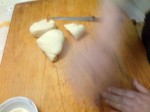I want to start a new cycle of blogging about traditions, customs, foods, sayings, and original recipes from my native Calabria.
This is my first blog on traditional recipes.
How to make “maccheroni fatti in casa”. In my home town of Montalto Uffugo we call them ‘maccarruni di casa’ — homemade macaroni. These are macaroni made using a very thin dried reed of the “busa” plant, or the willow tree.
 I called my mother last Thursday afternoon and I said to her: “Are you going to teach me how to make homemade macaroni like we talked about so many times? I’m coming over.”
I called my mother last Thursday afternoon and I said to her: “Are you going to teach me how to make homemade macaroni like we talked about so many times? I’m coming over.”
Here are the ingredients and the steps to make these delicacies for 4 people. flour – the best flour would be the Italian durum wheat double 00 type flour but it’s hard to find here in Canada. So what my mother found to be the best alternative, over years of experimenting, is Monarch Brand Pastry Flour – the one in the red and white chequered bag. You will start with about 500 g but then you will have to add a bit as you go along to achieve the correct consistency of the dough. The dough should not be too soft and it shouldn’t be sticky when kneading.
I asked my mother to be more specific on how much flour we actually use. This is always a mystery to me because I never get a quantifiable amount. It’s sort of a hit a miss or so it seems. But it’s base on expertise and years of accumlated know how.
“Farina quanta se ne riceve – as much flour as it is required”– in other words, you have to feel the consistency of the dough and stop adding flour at right time. It’s an art that is achieved after many years of experience but let’s just say that 500 g will be a good starting measure.
- 2 eggs – Note: use one whole egg and the yolk of the second egg
- A cup of warm water
- A small dish with a little bit of oil to use as lubricant for your hands and the reed or skewer
- A very thin dried branch of willow or other reed (Un rametto sottile di salice secco o di erba di busa per stendere i maccheroni).
This is used to roll the dough into long macaroni. You can substitute the willow reed with a thin knitting iron or other thin rod such as a wooden skewer – just remember; the thinner and straighter the reed, the better.
Let’s start:
- Place the flour in a bowl and make a well in the middle of it.
- Place the whole egg and the yolk in the flour well.
- Mix thoroughly with a fork and slowly add the warm water to achieve the desired consistency… as discussed below.
- Take out the freshly formed dough and knead thoroughly using your hands adjusting the texture of the dough by adding flour a bit at a time. The dough should not be sticky or feel too hard when pressed with your fingers. You should be able to work it with ease into cylindrical rolls. Keep the dough covered at all times and it’s best if the dough rests for at least half an hour to an hour or so in a cool place (the refrigerator is also a good place) before you start working it.
 Divide the dough into smaller portions roughly the size of an orange and work them into thinner cylinders the size of a cigarette.
Divide the dough into smaller portions roughly the size of an orange and work them into thinner cylinders the size of a cigarette.- Work with one portion at a time keeping the rest covered with a bowl or a clean cloth. Work on a large breadboard.
- Cut the cylinders into shorter lengths of about 5 cm each.
- Lightly oil the palm of your hands and the reed. You may need to this often during the process of making the macaroni.
 Using a very light pressure, roll the dough cylinders together with the reed or skewer using the palm of your hands so that the dough gently wraps around the reed and elongates into a large spaghetti about 20 to 25 cm long. The longer you can stretch the, the thinner they will be. But making them really thin and long requires lots of practice.
Using a very light pressure, roll the dough cylinders together with the reed or skewer using the palm of your hands so that the dough gently wraps around the reed and elongates into a large spaghetti about 20 to 25 cm long. The longer you can stretch the, the thinner they will be. But making them really thin and long requires lots of practice.- Gently pull the macaroni towards the thinner end of the reed or skewer and place it on a clean dry table cloth.
- Congratulations! You made your first Maccherone Calabrese.
- A good measure is to make about 20 to 25 macaroni per person.
Use a traditional Italian tomato sauce, preferably a meat sauce, to accompany the macaroni.
A generous dose of Parmiggiano Reggiano or Pecorino Romano cheese is used to cover the maccheroni and don’t forget to sprinkle some hot chilli peppers on top for good measure.
I will have a traditional recipe for that sauce soon but you need to wait for my next blog. 






 .
.


 Our plan for an exploratory walkabout around town was thwarted by the constant clouds of dust that lifted every time a truck would speed by. On our short, dusty walk we encountered a great number of stray dogs roaming the streets of the town. The next day we asked about the dogs and we were told that, for many reasons, it is very hard to neuter the pups. Thus dog population control is sadly carried out a few times a year during random shootouts.
Our plan for an exploratory walkabout around town was thwarted by the constant clouds of dust that lifted every time a truck would speed by. On our short, dusty walk we encountered a great number of stray dogs roaming the streets of the town. The next day we asked about the dogs and we were told that, for many reasons, it is very hard to neuter the pups. Thus dog population control is sadly carried out a few times a year during random shootouts.
